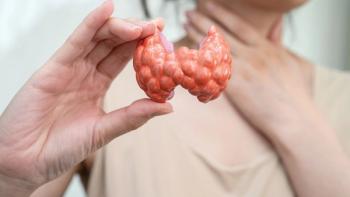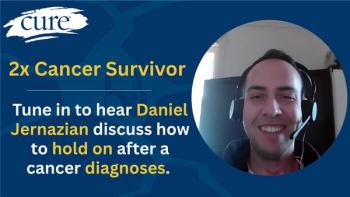
Radioiodine-Refractory DTC: An Overview of Work-up and Treatment Options
Health care specialists share insight on the work-up of patients with iodine-refractory differentiated thyroid cancer and how this may affect systemic therapy options.
Episodes in this series

Transcript:
Lori Wirth, MD: Let’s chat a little about treatment options for iodine-refractory differentiated thyroid cancer. We now have a number of drugs in our arsenal that are FDA approved. The first drug that was FDA approved was sorafenib, based on a clinical trial comparing sorafenib with placebo, or a sugar pill, in patients who had iodine-refractory thyroid cancer that we could see on and was growing on CT scans. Shortly after the approval of sorafenib, we had the approval of lenvatinib. That was studied in the similar-patient population with iodine-refractory thyroid cancer, which you can see on CT scans was growing over time. Those were the first two landmark, modern era drugs that were FDA approved. We generally think of them as multikinase inhibitors. The kinases are proteins that are in our cells and in cancers. Different kinases can become overactive, and that kinase activity can drive the growth of the thyroid cancer cells. The multikinase inhibitors can help block that growth signal, and that’s basically how they work. They can block other kinases in normal cells as well, and then cause side effects. In a way, it’s a double-edged sword in that regard.
More recently, we’ve had a few advancements with gene-specific therapies for a subset of patients with iodine-refractory thyroid cancer. There are a couple of genomic alterations that occur in thyroid cancers that drive the thyroid cancers. The most common that we see in differentiated thyroid cancers is in a mutation in the BRAF gene, BRAF V600E, and we can also see NTRK fusions, which are a different type of alteration that can drive a small subset of differentiated thyroid cancers. We also see RET fusions, fusions involving the RET gene, that can drive approximately 10% of differentiated thyroid cancers. We now have in our arsenal of oncology drugs gene-specific therapy for three different alterations, which are pertinent in a subset of thyroid cancers. Bryan, with that basic outline, when you’re taking care of a patient like Jim who has iodine-refractory thyroid cancer, what do you want to know about the thyroid cancer? What do you want to know in terms of picking the best drug for the patient? Then there’s always the decision on when to start therapy.
Bryan McIver, MD: We’ll come to that last point as perhaps the most contentious of any subject in this presentation because the decision about when to start treatment is truly challenging in this disease. Jim sounds as though he’s had a more aggressive course than average. But with patients with incurable thyroid cancer that has recurred in the neck or is present in other sites, that disease is often progressing gradually and not causing any symptoms. One of the most remarkable things about thyroid cancer is that you can be filled with this disease, with very high disease burden, yet it doesn’t make you feel unwell and it doesn’t make you sick. That’s very unlike some other types of cancer, like pancreatic cancer or lung cancer, where patients can absolutely feel miserable, and they’re wasting away and look as though they’re dying because their cancer is progressing. With thyroid cancer, that rarely happens. It often feels too early for any kind of chemotherapy. It’s too early for chemotherapy sometimes and then it’s too late for the chemotherapy, and we miss that window of opportunity.
We should be recognizing when somebody has thyroid cancer that is radioiodine refractory and unresponsive when that disease is progressing. That requires us to follow these patients carefully with thyroglobulin and other imaging studies. When we see disease progressing, the first question I want to understand is, what’s the genetic makeup of this cancer? What’s really driving it? We try to obtain tissue from the original surgery, subsequent surgeries, or a fresh biopsy to do molecular genetic testing. We use a panel developed here at Moffitt [Cancer Center], but you have a similar panel that looks at all the events that drive the known causes of thyroid cancer. That includes BRAF mutations, not just the V600E, but others as well. It includes the RET rearrangements. It includes the NTRK rearrangements. It includes the RAS mutations and TP53 and TERT mutations. All these things are important in terms of understanding the driving force for the cancer, which predicts the spread of the cancer, tells us our treatment options for the cancer, and informs our understanding of the prognosis of that cancer that we can share with our patient.
It’s a matter of understanding those genetic drivers and then, most important, where the cancer is. That requires us to do the appropriate scanning up to and including PET [positron emission tomography] scans in many patients. This is so we understand exactly where the cancer is, exactly the burden of cancer, how much cancer there is, how quickly it’s growing and whether it’s becoming threatening, so that we can make a decision to step in with treatment before that threat becomes manifest. We have to understand that the window of opportunity to treat is sometimes open early, but at some point, we have to make the decision to pull the trigger and treat.
Lori Wirth, MD: Gary, you wanted to weigh in?
Gary Bloom: Yes. When is the right time to do that evaluation? Do you do that evaluation of the underlying cells while the patient is still in that ark of getting RAI [radioactive iodine], or is it after the patient has been deemed radioactive iodine refractory?
Lori Wirth, MD: Gary, you’re talking about looking for gene stations?
Gary Bloom: Yeah.
Bryan McIver, MD: That’s a very important question, Gary. We recognize that most patients never need the systemic therapies. Most patients can be managed with the traditional approach of the surgery—radioactive iodine, thyroid hormone suppression—and for recurrences, we come back and we do more surgery, for example. The patients who run into trouble and need these systemic therapies are patients like Jim, where despite those traditional approaches, we’re not gaining control over the cancer. The moment we identify that this is one of those cancers that’s not coming under control with our standard approach, that’s when we typically look for genetic information. The reason to not do it earlier is because these tests are very expensive. We don’t want to bankrupt the health care system, and we certainly don’t want to bankrupt our patients to pay for a test if we’re not going to use the information.
In most cases, it’s unnecessary to do that testing when we’re dealing with what we’ve been calling in this seminar a garden variety thyroid cancer. It should be done with the more advanced ones, where we feel like we’re running into trouble and not getting under control. That’s the time when we need really the information. The good news is that we can almost always get that information because thyroid cancer isn’t a tiger that changes its stripes very often. Even if we have to go back to the original surgery, seven or 10 years earlier, as long as you can get ahold of that tissue, we can run the genetic analysis on that. For somebody like Jim, where the cancer keeps coming back, it’s pretty easy for us to repeat a biopsy in the area of recurrence and get that information from that material if we need to. Knowing Jim as I have come to know him over the last 40 minutes, I suspect we can do that without even needing anesthetic.
Gary Bloom: If you’re to repeat that test, is it possible that the results could change over time?
Bryan McIver, MD: That’s a very important research question that’s actively being pursued. From a clinical perspective, it’s not common to see something that has truly changed. If we go back and look at the original material and we look at a fresh biopsy, in most cases, we’re seeing the same mutational profile. In many cancers, they acquire numerous mutations and have what’s known as a high tumor mutational burden, with lots and lots of mutations. In thyroid cancer, the mutational burden is typically quite low. It’s one, two, or sometimes three mutational drivers, but rarely is it more than that, except in poorly differentiated thyroid cancer or anaplastic thyroid cancer, which is a completely different story.
Transcript edited for clarity.






